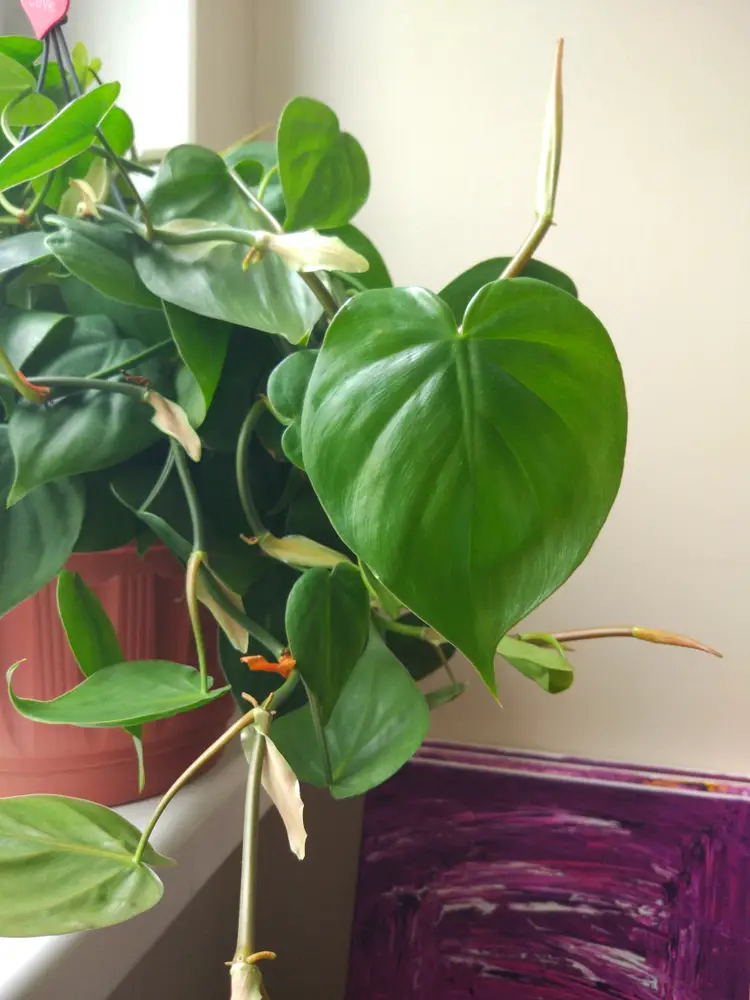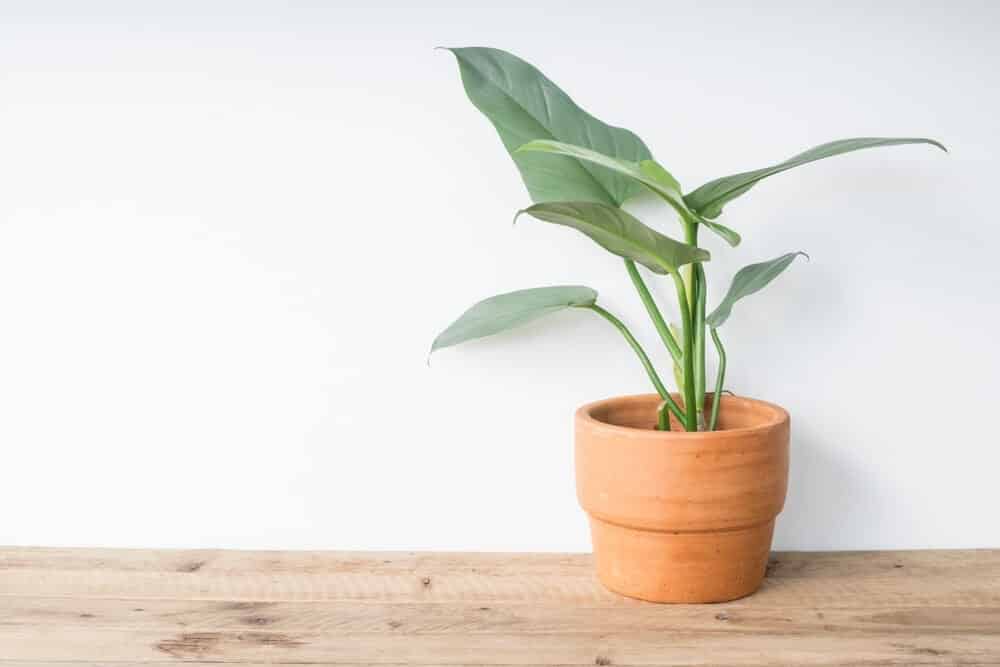It can be difficult to tell the difference between a pothos and a philodendron plant if you don’t know what to look for.
In this article, you will learn about some of the key things that make these plants unique.
Once you have this information, you won’t have any trouble telling them apart.
Differences between Pothos vs Philodendron
1. The shape of the Leaves
First we will take a look at the difference between the shape of the leaves with these two plants.
The Pothos plant has narrow, heart shaped leaves with a fine point, whereas the Philodendron has broader leaves with a blunt point. This is one of the easiest ways to identify which is which.
2. Sheath
When you want to tell the difference between these two plants, you can also look at the sheath coming from the nodes.
3. Leaf Texture
You’ll also find that the overall texture of the leaves of these plants is very different as well.
When you run your fingers along a pothos leaf, you will notice that it has a waxy feel with a somewhat raised texture. These leaves are soft but not entirely smooth.
The philodendron has a noticeable smoother overall texture than that of the pothos leaf. You won’t notice any significant bumpiness whatsoever.
4. Petiole
The petiole is the part of a plant that connects the leaf to the vine. Pothos plants have a petiole that is almost round but not quite, and they have a distinct indentation. Philodendron plants have a very round petiole that is entirely consistent all the way through.

5. Foliage Color
The foliage color of these two plants is also very distinct. You will find that pothos plants have a white or silver coloration most of the time, though it depends on the variety. A pothos plant’s leaves can become pale and faded when it doesn’t get enough light on a daily basis.
Philodendron foliage tends to be completely green without any break in the color whatsoever. There is also a characteristic shine to this plant’s leaves that is not present with pothos.
6. Varieties
It is important to keep in mind that there are numerous varieties of each plant.
1. Pothos
Some of the different pothos varieties include Jade, Pearls and Jade, Cebu Blue, and Marble Queen. Keep in mind that each variety has a slightly different appearance, so it is important that you are familiar with each one.
2. Philodendron
There are lots of different philodendron species, including Heart Leaf, which grows very long but not wide. The Philodendron Brasil variety has a beautiful yellow and green coloration.
7. Flowers
These plants both produce flowers that resemble a smaller version of the peace lily, which is quite pretty to say the least.
Philodendron plants produce flowers that are green throughout the entire year, whereas pothos plants have flowers that are purple, yellow and green. Pothos plants usually don’t flower when they are planted outside, as there is too much temperature variation.
8. Overall Size
Most pothos plants grow to be around three feet long and four feet across when grown inside. There are, however, certain varieties that can grow up to 65 feet long.
Philodendron plants are usually five to six feet long when they are grown inside. The tree philodendron can easily reach 10 to 15 feet long.

Water Needs
Both of these plants need to be kept in soil that is damp pretty much all of the time. The thick leaves of pothos plants mean that they can go without water for longer than the philodendron.
Food Needs
You only have to fertilize both of these plants a couple of times each year. This is just one of the many things that make these plants fairly low maintenance.
Air Roots and Stems
The stems of philodendron plants are a sort of greenish brown color. There are also extended stems close to the base of the plant with a dark orange coloration. Both of these plants feature air roots that provide the plant with nutrients as well as moisture to keep them healthy.
When you look at the aerial roots of pothos plants, you will notice that they are much thicker and have only a single root coming from a node. The aerial roots of philodendron plants often grow in clusters of two to six at a time; they tend to be fairly slim.
Climate
Both of these plants tend to thrive in tropical climates. They need a good amount of indirect sunlight on a daily basis to grow strong and healthy. Excess direct sunlight can harm these plants and kill them fairly quickly. It is important to keep this in mind if you ever plan on growing either of them.
Pothos plants are native to the Solomon Islands. If you ever visit this part of the world, you will see these plants creeping up many of the trees.
The heartleaf philodendron is native to Brazil, the West Indies, and Mexico. Both plants can thrive in all of these places under the right conditions. They are both very durable plants that can withstand fairly harsh conditions.
Also read: Direct vs. Indirect Light: Find the Right Sunlight Levels for Plants
Conclusion
- Pothos plants have narrow, heart-shaped leaves while philodendron plants have broader leaves with a blunter point at the end.
- The texture of pothos plant leaves is waxy and slightly bumpy. Philodendron leaves are completely smooth.
- Pothos plants have leaves with a silver or white coloration, whereas philodendron leaves are completely green.
- The flowers that both of these plants produce look like smaller versions of Peace Lilies.
- Pothos plants usually grow up to three feet long and four feet across.
- Philodendron plants typically grow up to six feet long.
- These plants both need to be kept in damp soil all of the time. They will die quickly if left in bone dry soil for too long.
- Both plants do very well in tropical climates, but they come from different parts of the world.
- You only have to fertilize these plants about two times every year.
Victoria is the owner and main author of hobby plants. She loves spending her free time in her garden planting and taking care of her plants. Victoria hopes you enjoy the content here!